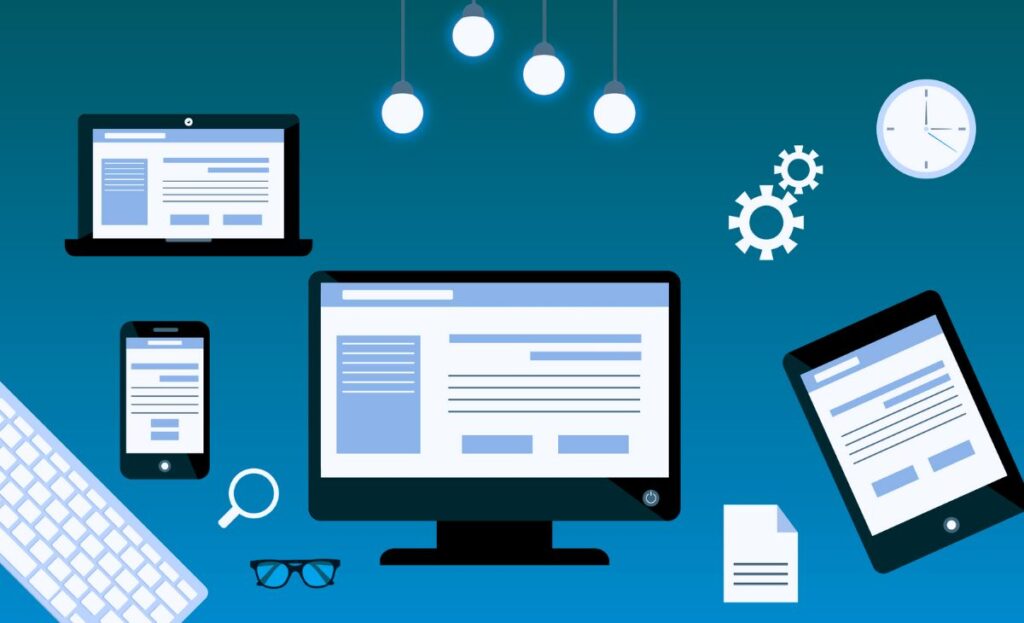Why Screen Readers Are Essential for Testing Website Accessibility
Screen reader compatibility is an important part of providing seamless digital experiences for all users. With more people relying on assistive technologies to interact with web content, businesses need to conduct screen reader accessibility testing.
But how do screen readers work? Are they all the same? Why is screen reader accessibility testing so important to provide accessible web experiences? And how to test screen reader accessibility?

What are Screen Readers, and How Do They Work?
Screen readers are specialized software programs that interpret visual information and translate it into an audio or Braille output for people with vision impairments. They capture all text, images, menus, buttons, and other visual elements in operating systems, web browsers, documents, or applications. The screen reader then converts this visual information into synthesized speech that is read aloud or output to a refreshable Braille display.
On desktop devices, typical screen readers include free options like NonVisual Desktop Access (NVDA), JAWS for Windows, and VoiceOver for Mac devices. Most screen readers also allow magnification of content, color contrast adjustment, and other modifications to support low-vision users. Some screen readers are built into mobile operating systems like iOS and Android to enable accessibility on smartphones and tablets.
Screen readers do not simply read all visual information from left to right. The underlying source code tells the assistive technology about key content pieces and relationships between information. Web developers need to properly structure pages using semantic HTML that identifies main landmarks like headings, navigation, and body sections.
Appropriate coding also clarifies when certain text comprises readable sentences vs. functional elements like buttons that can be activated. Adding supplemental ARIA attributes provides further guidance about elements’ roles and names to optimize interpretation.
The other key to screen reader functionality is alternative text (alt text) for images, which screen readers cannot analyze visually. Concise but descriptive alt text ensures users understand non-text elements. Videos and audio content also need text alternatives like captions and transcripts. With all these measures in place, people using screen readers can effectively navigate and utilize digital interfaces.
Who Uses Screen Readers?
Screen readers users are people who are blind or have some visual disability, making it challenging to interpret content visually. Many screen reader users still have some vision but have an impairment like low acuity that prevents reading text. Seniors dealing with age-related vision loss also frequently employ screen readers.
Desktop vs. Mobile Screen Readers
Historically, screen readers were software programs installed on desktop PCs or laptops. On the other hand, mobile screen readers are now just as popular, built into smartphones and tablets. Popular options for mobile screen readers include VoiceOver on iOS and TalkBack on Android. Mobile users rely on gestures like swipes and taps instead of arrow keys for navigation.
Why Does Screen Reader Accessibility Matter?
Enabling screen reader accessibility is essential for allowing people with vision disabilities to access digital content and fully participate online independently. While not all visually impaired individuals use screen readers, they are an essential assistive technology for many.
Beyond those with diagnosed vision loss, about 12% of screen reader users do not have a specific disability. Screen readers empower people with learning differences, attention disorders, mild vision issues, or other barriers to benefit from technology. Making websites and apps accessible supports inclusion and prevents these groups from being left behind digitally.
On top of that, numerous countries require web accessibility screen reader compliance by law, including adherence to guidelines like the internationally recognized Web Content Accessibility Guidelines (WCAG).
In 2015, the National Association of the Deaf (NAD) filed a federal class action lawsuit against Harvard University and the Massachusetts Institute of Technology (MIT), alleging that the universities violated accessibility laws. The lawsuit contended that Harvard and MIT failed to provide accurate closed captioning for online videos and audio content from their free open course programs.
The lawsuits were settled in February 2020 through consent decrees, with the universities agreeing to ensure equal online access moving forward. Additionally, Harvard was liable for $1,575,000 in attorney’s fees and costs to the Class Counsel representing the case. This is why failing to provide accessibility opens businesses up to legal risks and penalties.
Screen Readers and the WCAG
The Web Content Accessibility Guidelines (WCAG) provide criteria and standards for measuring accessibility. Several of the compliance guidelines specifically mention screen reader accessibility and compatibility; this includes rules such as:
● Info and Relationships. Information, structure, and relationships conveyed through visual presentation must be programmatically determined or available in the text; this enables screen readers to understand page organization.
● Meaningful Sequence. Content must have a logical reading order to make sense when read serially by a screen reader.
● Sensory Characteristics. Instructions should not depend solely on sensory details like shape, color, or position, which a screen reader user cannot perceive.
● Color. Color should not be used as the only way to convey meaning, such as errors or required form fields. Messages must be understandable when all color is removed.
Conducting screen reader tests helps spot where deficiencies may lead to struggles for users affected by blindness, vision issues, or other disabilities.
Why Screen Reader Accessibility Testing Matters?
A website not compatible with screen readers poses challenges for blind and visually impaired users. They may be unable to understand and interact with website content and use suggested features which leads to a poor user experience and loss of potential customers. Screen reader accessibility testing helps gain first-hand experience with the obstacles and barriers faced by users who rely on them to access the content. These may include missing alt texts for images, poor website navigation, and headings. These insights allow businesses to meet the needs of this audience better and improve overall accessibility.
Failing to comply with accessibility laws and legislation means businesses risk breaking the law and facing fines. Screen reader accessibility testing helps businesses comply with WCAG, Americans with Disabilities Act (ADA).

How to Conduct Screen Reader Testing?
Testing websites with a screen reader is essential to the accessibility testing process, but it does not guarantee that the site is fully accessible. Screen readers allow users who are blind or visually impaired to navigate web content through audio rather than visual cues. To properly test with a screen reader, follow these guidelines:
Choose a Screen Reader
The first step is selecting a screen reader to use for testing. Some popular options include JAWS for Windows, NVDA for Windows, and VoiceOver for Mac.
Learn Screen Reader Navigation
Before beginning testing, spend time learning keyboard shortcuts and gestures to navigate with the screen reader; this will allow a more accurate simulation of how a user operates it. Common tasks include:
● Reading text aloud
● Jumping between headings and other landmarks
● Interacting with form fields and other interactive elements
● Test All Pages and Functionality
Thoroughly test the site’s content and functionality, including pages, multimedia, forms, menus, and any custom interactive components. Read all text aloud and verify that all elements are appropriately labeled for screen reader users. Make sure navigation and the overall logical flow make sense when accessed non-visually.
Have Someone Else Test
It’s also important to get feedback from someone else testing with a screen reader. Over time, testers can overlook accessibility issues they are used to hearing. An objective co-tester will be able to catch new issues more easily. Check for:
● Missing/improper headings
● Language attribute on HTML
● If forms work properly
● If buttons, links, and images have descriptive text
● Problematic elements like CAPTCHA
● Skip to the main content links
Consider Limitations of Any One Tool
While screen readers provide an important perspective, remember that testing with just one will not uncover all accessibility barriers. Color contrast, layout, keyboard support, and other factors still need to be evaluated. Screen reader testing alone cannot guarantee that the site is fully accessible to all people with disabilities. It is a valuable part of the testing process combined with other techniques.
Regularly Re-Test and Update As Needed
Accessibility is an ongoing process. Make screen reader testing a routine part of the development and QA cycles to identify and address new issues early. Consider it an important—but not the only—step toward an inclusive user experience for all.
How Often Should You Test Your Website with Screen Readers?
While comprehensive accessibility should be an ongoing process, screen reader testing should occur at a minimum:
● Whenever making major edits or additions to site content
● As part of any more extensive site migrations or redesigns
● During general site maintenance and upkeep
Essentially, test screen reader compatibility early and often. Testing early allows for catching issues before launch rather than addressing them retroactively. Running frequent checks helps spot any new barriers that may have emerged on existing site pages.
Make screen reader testing a consistent part of the site management procedures, not a one-and-done exercise.
Conclusion
Conducting screen reader testing is an integral part of building an accessible website. It allows site owners to directly experience any barriers preventing visually impaired users from accessing content and features.
Rather than a one-time check, screen reader testing works best when integrated regularly into the development cycle. From the initial design phase through ongoing updates, consistent evaluation helps catch new problems early. It also confirms that equivalent experiences remain available as content evolves over time.
Involving screen readers from the start prevents accessibility from becoming an afterthought too late in the process. Catching issues early through iterative testing saves both time and resources down the road. It shows a commitment to building accessible interfaces for people with diverse abilities.
Contact Us
Please complete all fields.
Recent Posts

How to Write Content That Follows Web Content Accessibility Guidelines
Accessible content is a must for everyone, regardless of ability, to easily browse, comprehend, and interact with the information. It first became a facilitator of users, a trust-sponsor, engagement-booster, and quality-enhancing and reach-extending factor for all digital experiences. Why Accessible Content Matters This approach benefits people with disabilities, older adults, […]

Web Accessibility Laws and Legislation
More often than not, a website is the first impression for potential customers. Because of this, it’s no surprise that today, web design is a $38.3 billion industry.

The Importance of Digital Accessibility for Financial and Banking Websites
Inclusive design helps make everyday services easier to use for people with disabilities. This is particularly important for financial websites, where users need to access sensitive information and complete transactions securely and independently. By prioritizing accessibility, these websites can remove barriers related to vision, hearing, mobility, or cognitive differences, creating […]